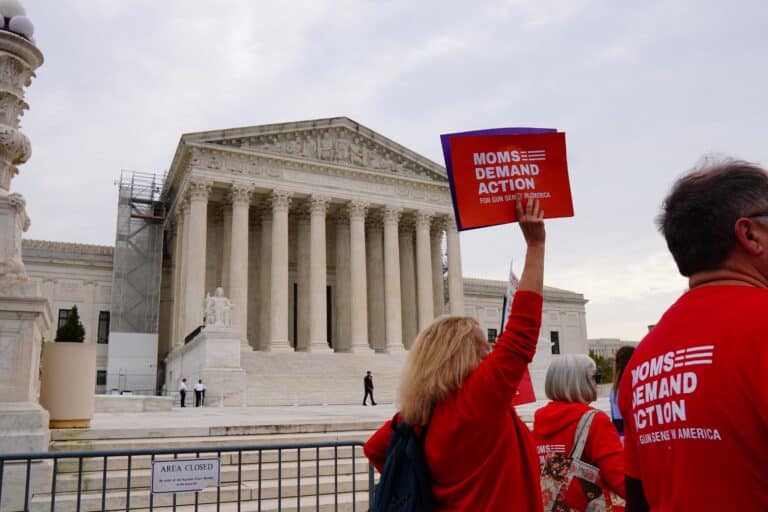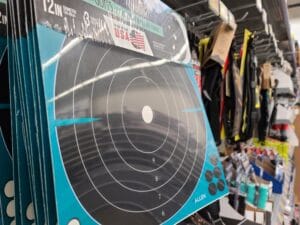The nation’s highest court set its sights on the details of a 90-year-old federal law regulating machine guns to see if the definition fits bump stocks as the ATF claims.
On Wednesday, the Supreme Court heard oral arguments in Cargill v. Garland. The case challenges the bump stock rule implemented by the Trump Administration, and defended by the Biden Administration, which effectively outlawed the possession of the devices. The justices spent most of their time trying to discern the meaning of the 1934 National Firearms Act (NFA), which defined and heavily restricted the ownership of machine guns. Much of the argument centered on whether bump stocks allow a shooter to automatically fire their gun more than once with a single “function of the trigger,” as the NFA definition of machine gun requires.
“I read the word ‘function’ to be doing significant work in this statute,” Justice Ketanji Brown Jackson said.
The case’s outcome could cast a long shadow over the ATF rulemaking that President Joe Biden has based much of his gun policy agenda around. If the Court ultimately finds the ATF overstepped its authority in reclassifying bump stocks, that could spell doom for the President’s other rule-based bans on so-called ghost guns, pistol braces, and many private used gun sales. If it sides with the agency, the administration will have a clearer path toward winning cases against those related policies.
Controversy over bump stocks stems from the 2017 Las Vegas mass shooting, where a lone gunman sprayed bullets into a crowd at a music festival with an arsenal that included bump-stock-equipped AR-15s. It remains the only recorded crime committed with a bump stock, but also the worst mass shooting carried out by a single person in American history, with the attacker killing 60 people. In response, then-President Donald Trump ordered the ATF to ban the devices through rulemaking.
That led to the ATF flip-flopping on whether the devices met the definition of machine guns under the NFA. When bump stocks came on the market, it said the devices were merely stocks and not subject to NFA regulations. However, it changed course after direction from Trump.
Since President Trump initiated the reclassification, federal courts have issued conflicting rulings on the matter. Despite this, Trump has remained steadfast in supporting the ban as he pursues the 2024 Republican presidential nomination. At a CNN town hall in May, he defended the move by downplaying the significance of bump stocks and highlighting the NRA’s approval of the ban.
“As you know, the bump stocks are actually a very unimportant thing,” Trump said. “NRA I went with them, and they said, ‘it doesn’t mean anything, or actually all they do is teach you how to shoot very inaccurately.’ So, we did that.”
In January 2023, an en banc panel of the Fifth Circuit Court of Appeals deemed the ban an overreach of executive authority and struck it down.
“A plain reading of the statutory language, paired with close consideration of the mechanics of a semi-automatic firearm, reveals that a bump stock is excluded from the technical definition of ‘machinegun’ set forth in the Gun Control Act and National Firearms Act,” Judge Jennifer Walker Elrod wrote for the majority in Cargill.
The government then appealed the decision, and the Supreme Court took up the case.
The lower courts had dealt at length with the ATF’s flip-flopping on how bump stocks should be categorized and how that could implicate the rule of lenity–where courts favor defendants if the government’s interpretation of a statute is unclear. But the justices focused most of their time on what “function of the trigger” means.
“Can I just be clear on this function point? Because they say, I think, that a single function of the trigger as it appears in this statute is directing consideration of whether the trigger is moving only once. And I think you’re saying that, no, when it says the function of the trigger, it’s not how the trigger operates, function of the trigger is what it achieves,” Brown Jackson said to Deputy Solicitor General Brian Fletcher. “I think you’re saying that if by single operation, meaning single movement of the person, you can achieve firing multiple shots without multiple manual movements, that’s what you said, that covers the function of the trigger.”
“I think the thing that makes this clearest is the boxes hypothetical on page 30 of our brief where we say imagine somebody builds a black box with a button on the top and the shooter pushes the button once and bullets come out of the front at a very high rate,” Fletcher responded in part. “In our view, that’s a machinegun.”
Jonathan Mitchell, the lawyer representing Cargill, disputed that description. He argued a function of the trigger is “what the trigger does to cause the weapon to fire” and noted the trigger resets after each individual shot when using a bump stock. That means it has to be actuated again by the shooter in order to fire each subsequent round.
“There’s the recoil after the shot gets fired, and then it is the shooter who must, with his own hand and with his own force, exert pressure forward, consistently to make sure that the trigger bumps into his finger,” Mitchell said. “This is all manual. Nothing automatic about it. Nothing at all.”
Fletcher conceded the trigger had to be depressed for each round fired with a bump-stock-equipped rifle, but he said that was all part of a continuous automatic sequence.
“Our view is that those subsequent movements of the trigger aren’t functions of the trigger because they’re not responding to separate acts, separate pulls, or anything else by the shooter,” he said. “So, from the shooter’s perspective, we view it as one act.”
But the questions on how exactly bump stocks work and what constitutes a “function of the trigger” poured in from the justices. Justice Clearance Thomas asked about bump firing without using a bump stock.
“What is happening with the trigger when someone doesn’t need a bump stock to bump-fire a weapon?” he said.
“We don’t think those things function automatically because the definition of ‘automatically,’ I think everybody agrees, is by means of a self-regulating mechanism,” Fletcher responded. “That’s what a bump stock is. It’s a device that is purpose-built to harness the recoil energy of the gun to automate the process of releasing the trigger, to move the rifle back just the right distance in just the right direction so that the trigger resets, and then to ensure that the rifle moves forward again, again, just the right distance, just the right direction.”
Justice Neil Gorsuch questioned the government’s grammar in how it read the statute.
“A function of the trigger, do people function triggers?” he asked. “I thought, maybe somewhere in fifth-grade grammar, I learned that was an intransitive verb.”
He and Justice Amy Coney Barrett expressed sympathy toward the idea that maybe bump stocks should be restricted in the same way machine guns are. However, given how the law is currently written, they weren’t sure that was something for the ATF to decide.
“Look, intuitively, I am entirely sympathetic to your argument,” Barrett said. “I mean, it — and it seems like, yes, that this is functioning like a machinegun would. But, you know, looking at that definition, I think the question is, why didn’t Congress pass that litigation — I mean that legislation to — to make this cover it more clearly?”
“Maybe they should have written something better. One might hope they might write something better in the future,” Gorsuch said. “But that’s the language we’re stuck with.”
Justice Brett Kavanaugh shared a similar critique but focused on the government’s flip-flopping in classifying bump stocks.
“If your position were correct, ‘oh, just this is a new thing, obviously, covered by this old statutory language,’ you would expect the Bush Administration, and the Obama Administration, and Senator Feinstein to say, of course, it’s covered by, and — and they didn’t, and that’s reason for pause,” he said. “It’s not dispositive, but it’s reason for pause.”
He and Justice Gorsuch also expressed concern at the sweeping consequences of reclassifying bump stocks.
“That’s going to ensnare a lot of people who are not aware of the legal prohibition,” Kavanaugh said.
“You’re creating a class of, again, between a quarter of a million and a half million people who have, in reliance on past administrations, Republican and Democrat, who said that this does not qualify in a very old statute, taken actions,” Gorsuch added.
“The problem here, we acknowledge, is ATF used to say something different about these, but we think that’s taken care of by the rulemaking and the doctrine of entrapment by itself,” Fletcher responded.
Gorsuch mocked his claim that the rulemaking process would make bump stock owners aware they risked federal prison for holding on to gun accessories they’d bought years before.
“Because people will sit down and read the Federal Register?” he said with a laugh. “That’s what they do in their evening for fun. Gun owners across the country crack it open next to the fire and the dog.”
Fletcher argued the ATF gave owners the option to turn in or destroy their bump stocks rather than face prosecution. And he admitted, “It would be horribly unfair to prosecute people who possessed these devices in reliance on the agency’s past assurance.” But he also assured the justices the ATF wouldn’t prosecute people for owning the devices before the ban was implemented and noted time had nearly run out to prosecute anyone who didn’t comply with the rule regardless.
“As a practical matter also, the statute of limitations for this offense is five years, so in a month, the statute of limitations would be gone,” Fletcher said. “We have not prosecuted those people. We won’t do it. And if we try to do it, I think they would have a good defense based on entrapment by estoppel.”
At points, the oral arguments devolved into highly-abstract hypothetical arguments about potential firing mechanisms and whether they would qualify as machine guns under the NFA. The justices crafted different theoretical guns and asked each side whether they fit the definitions.
“So now, instead of doing two buttons, suppose you had one button, and with the other hand, you held the trigger,” Justice Elena Kagan said.
“A bump stock does not change the trigger in any way. It does not alter the nature of the trigger,” Mitchell responded after a lengthy back and forth. “The other hypothetical devices that Your Honor is describing are changing the triggering device either by requiring pushing two buttons rather than just one, nothing in the bump stock changes the trigger.”
“This conversation is totally confusing me because I thought that your argument depended on what the trigger — that the function of the trigger was what the trigger does mechanically inside the weapon, and, therefore, whether you have one trigger or two triggers or three triggers or ten buttons, it doesn’t matter,” Justice Samuel Alito chimed in. “What matters is what the trigger or the triggers do inside the gun.”
“No, you’re not misunderstanding at all,” Mitchell told Alito. “The function of the trigger is what the trigger does to cause the weapon to fire. That’s what ‘function of the trigger’ means.”
“Now I’m completely lost,” Sotomayor replied. “The trigger is not doing anything. It’s the person doing something.”
Justice Gorsuch put a finer point on a lot of the questions asked of Mitchell toward the end of the argument.
“It seems to me the spirit of some of the questions you’re getting are in the nature of the anticircumvention principle,” he said. “The high rate of fire that’s achievable through bump stocks is effectively the equivalent, and we should take cognizance of that.”
“It’s just not what the statute says,” Mitchell responded. “It has nothing to do with the rate of fire.”
Oral arguments are not always predictive of where the Court will end up in a case. Sometimes, justices ask questions that don’t necessarily represent where they ultimately stand on the question at issue in a case. However, if Wednesday’s hearing is any indication, the case will be decided by who convinces enough justices their interpretation of “function of the trigger” is correct.
“The back-and-forth here leads me to believe that, at best, there might be some ambiguity,” Justice Elena Kagan said. “Now the question is, ‘What’s the best reading?’







8 Responses
Typo midway down, I believe, quoting Fletcher, “…taken care of by the rulemaking and the doctrine of entrapment by itself.”
Was listening yesterday morning, and I believe he said “entrapment by estoppel,” which is where the LEO would have told you something was legal even though it wasn’t and you relied on their determination. It obliterates mens rea if you had it on good authority that the action was legal.
I blame your spell checker though I haven’t seen transcript, maybe an error there too??
Oh maybe I should have kept reading.. did he not say estoppel the first time? My bad?
Yea, it’s from another point where he said it. I’m still a bit unclear on his argument, though. It sounds like they’re not going to prosecute anyone for keeping their bump stocks. But that doesn’t make much sense since the ATF now considers them unregistered machineguns.
I believe that when a law is enjoined the gov can still go back and prosecute you for possession during the time the injunction was in effect, IF they ultimately win the challenge to the law (and injunction lifted). So I think that’s all they were committing to – they wouldn’t go back and prosecute people who were in possession after the rule went into effect, even if ATF wins here. But going forward, if they win, expectation is that sellers and possessors should be well aware and all bets are off – stocks better get lost in a boating accident. That’s how I understood it anyway. And when is that ever considered a government taking? Like ATF decides some store’s inventory is suddenly verboten despite earlier assurances to the contrary, investment lost due to gov discretionary action. I mean, there’s explicitly no grandfathering in the ban, correct?
BTW, I really loved that pull quote from Sotomayor: “Now I’m completely lost,” Sotomayor replied. “The trigger is not doing anything. It’s the person doing something.”
Wisdom from the mouths of babes. Therein lies the whole criticism against gun bans in the first place. I know that wasn’t her point (or a flash of enlightenment) but funny to hear her say it nonetheless.
Honestly, reading the exchange again, it really seems like the government is saying it won’t prosecute people who bought bump stocks back when the ATF said they weren’t illegal. I don’t think it’s limited to just people who turned in or destroyed their bump stocks. But it’s hard to say for sure. I’ll have to reach out to DOJ and see what they say.
Here’s more of the exchange between Sotomayor and Fletcher:
SOTOMAYOR: Are you representing on behalf of the government that you’re not going to prosecute anyone prior to 2017? Anyone who wasn’t a felon or — or disqualified for some other reason?
MR. FLETCHER: I am. ATF made very clear in enacting this rule that anyone who turned in their bump stock or destroyed it before March of 2018 would not face prosecution. As a practical matter also, the statute of limitations for this offense is five years, so in a month, the statute of limitations would be gone. We have not prosecuted those people. We won’t do it. And if we try to do it, I think they would have a good defense based on entrapment by estoppel.
Of course, that exchange came after an earlier one with Justice Alito where Fletcher suggested continued possession probably would constitute a crime. I’m not sure if his later comments to Sotomayor constitute a walk back from this or not.
JUSTICE ALITO: What is the situation of people who have possessed bump stocks between the time of the ATF’s new rule and the present day or between the time of the new rule and the Fifth Circuit decision? Can they be prosecuted?
MR. FLETCHER: I think probably yes, unless they had gotten some judicial relief from the rule. The rule has not been enjoined. It hasn’t been vacated, writ large, so I think the — the government has made clear that this is what we think the statute means.
Well I compartmentalize things to try and understand. I think you have three categories of people with bump stocks: 1) those who purchased and possessed prior to the new interpretation, and who, in line with ATF’s advice, destroyed or turned them in at that time; 2) those who acquired bump stocks before or after the rule, but did not destroy them while this case is being decided; 3) those who would possess them after the court hypothetically rules for the ATF. I took Fletcher to mean that category 1 would not be prosecuted (“anyone who turned in or destroyed” is the big qualifier here). Anyone in category 2 is on shaky ground (“the rule hasn’t been enjoined. It has not been vacated [and we expect them to be aware of their new status as felons]”). Anyone in category 3 would be doomed.
But yeah, that “turned in or destroyed” is a really big qualifier for the pre-existing owners. It doesn’t seem like there’s any air cover for someone who bought a bump stock before the change and continues to possess it going forward. Like the purchase was in the clear (entrapment by estoppel), the possession prior to new rule is covered, but ignoring the order to turn them in or destroy them now would be highly risky if ATF wins here.